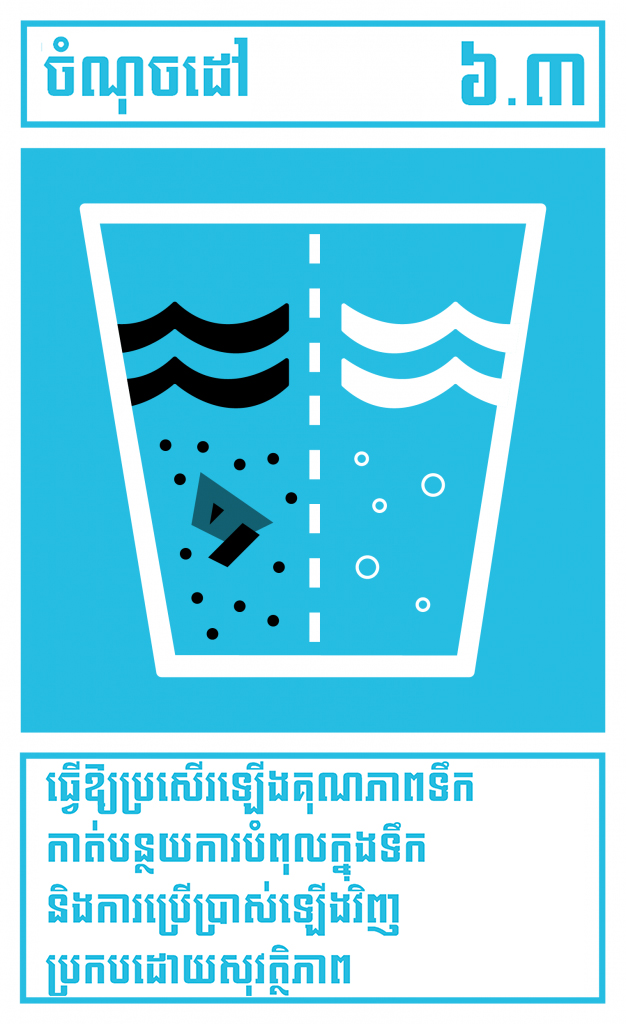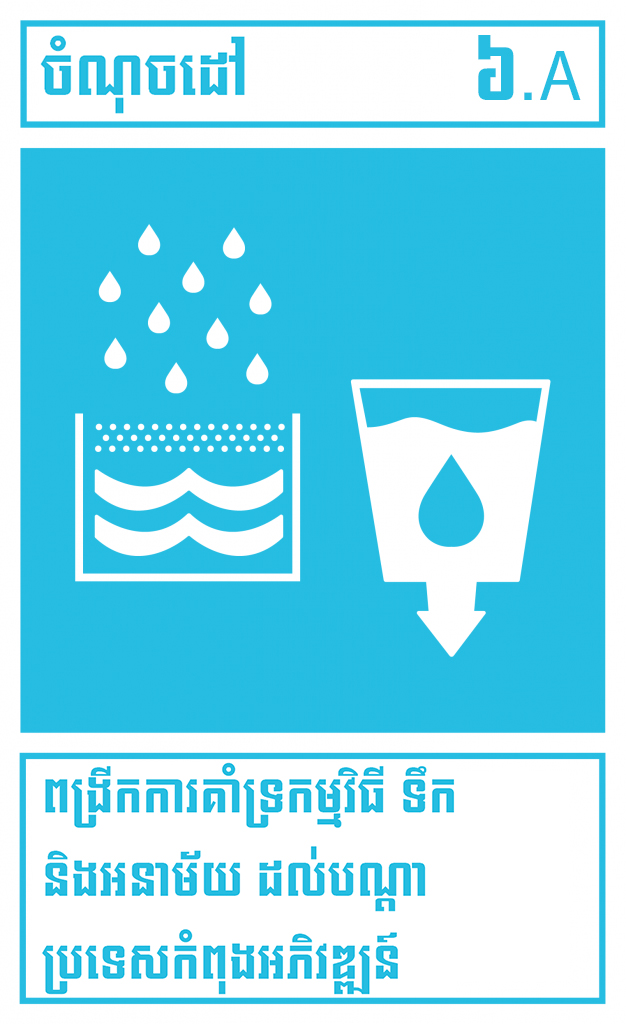គោលដៅអភិវឌ្ឍន៍ប្រកបដោយចីរភាពទី ៦ មានចំណុចដៅចំនួន ៨ និងសូចនាករចំនួន ១១ ដែលនឹងត្រូវប្រើដើម្បីជម្រុញសកម្មភាពឆ្ពោះទៅរកការទទួលបានជាសកលនូវការគ្រប់គ្រងទឹកស្អាត និងអនាម័យដោយសុវត្ថិភាព និងការគ្រប់គ្រងធនធានទឹកសមស្រប។1
គោលដៅអភិវឌ្ឍន៍ប្រកបដោយចីរភាពទី៦ ទទួលស្គាល់ ការគ្រប់គ្រងទឹកប្រកបដោយចីរភាព សំដៅលើការផ្គត់ផ្គង់ទឹកស្អាត (ចំណុចដៅ ៦.១) និងអនាម័យ (ចំណុចដៅ ៦.២) ដែលជាសិទ្ធិមនុស្សជាមូលដ្ឋាន។ គោលដៅនេះ ក៏ផ្តោតលើបញ្ហាដូចជា គុណភាពទឹក និងការគ្រប់គ្រងសំណល់រាវ (ចំណុចដៅ ៦.៣) កង្វះខាតទឹក និងការប្រើប្រាស់ទឹកប្រកបដោយប្រសិទ្ធភាព (ចំណុចដៅ ៦.៤) ការគ្រប់គ្រងធនធានទឹក (ចំណុចដៅ ៦.៥) និងការការពារ និងការស្តារប្រព័ន្ធអេកូឡូស៊ីទាក់ទងនឹងទឹក (ចំណុចដៅ ៦.៦)។2
  |   |   |   |
វឌ្ឍនភាព “វដ្តទាំងមូលនៃទឹក” ទាមទារឱ្យមានការបញ្ចូលទាំងអ្នកប្រើទាំងអស់ និងការប្រើប្រាស់ទឹក និងសមតុល្យតម្រូវការដោយសមភាព។ ចំណុចដៅនីមួយៗ នៃគោលដៅអភិវឌ្ឍន៍ប្រកបដោយចីរភាពទី៦ តម្រូវឱ្យមានការអនុវត្តទាំងអស់ ប្រសិនបើគោលដៅអភិវឌ្ឍន៍ប្រកបដោយចីរភាពទី៦ទាំងមូលនឹងត្រូវបានសម្រេច នោះគ្រប់ចំនុចដៅនីមួយៗ ត្រូវតែត្រូវបានអនុវត្តន៍រួមគ្នា។ ជាងនេះទៅទៀតទឹកស្អាត និងអនាម័យត្រូវបានគេកំណត់ថា មានសារៈសំខាន់ ពីព្រោះប្រសិនបើវាមិនអាចត្រូវបានសម្រេច វាកាន់តែពិបាកក្នុងការសម្រេចនូវគោលដៅអភិវឌ្ឍន៍ប្រកបដោយចីរភាពដទៃទៀត។3
ការផ្លាស់ប្តូរពីគោលដៅអភិវឌ្ឍន៍សហស្សវត្សរ៍ស្តីអំពីទឹក ទៅកាន់គោលដៅអភិវឌ្ឍន៍ប្រកបដោយចីរភាពទី៦ សម្រាប់ទឹក និងអនាម័យ
មានតែចំណុចដៅ ៧C នៃគោលដៅអភិវឌ្ឍន៍សហស្សវត្សរ៍ប៉ុណ្ណោះ ដែលសំដៅលើបញ្ហាទឹក និងអនាម័យ។ ចំណុចដៅនេះមានគោលបំណងសម្រេចឱ្យបាន យ៉ាងហោចណាស់ពាក់កណ្តាលនៃប្រជាជនដែលមិនមានលទ្ធភាពទទួលបានជានិរន្តរភាពនូវទឹកស្អាត និងអនាម័យនៅឆ្នាំ ២០០០ អាចទទួលបាននូវការប្រើប្រាស់ត្រឹមឆ្នាំ ២០១៥។ គោលដៅនេះ ត្រូវបានវាស់វែងដោយសូចនាករចំនួន២៖ សមាមាត្រនៃមនុស្សដែលប្រើប្រាស់ (១) ប្រភពទឹកស្អាតដែលបានកែលម្អហើយ (២) និងបង្គន់អនាម័យដែលបានកែលម្អ។ ចំណុចដៅទាំងនេះ ចាំបាច់ត្រូវផ្លាស់ប្តូរបន្តិចបន្តួច ដើម្បីសមស្របនឹងបរិបទនៃប្រទេសកម្ពុជា។ ដោយសារលក្ខខណ្ឌនៅទីជនបទ មានភាពលំបាកជាងបណ្តាប្រទេសដទៃទៀត សូចនាករនានាត្រូវបានធ្វើឡើងកាន់តែងាយស្រួល។ នៅត្រឹមឆ្នាំ ២០១៥ ប្រជាជននៅទីក្រុង ៨០ ភាគរយ និង ៥០ ភាគរយនៅទីជនបទ នឹងត្រូវតែមានលទ្ធភាពដើម្បីប្រើប្រាស់ប្រភពទឹកស្អាតដែលបានកែលម្អ។ ហើយប្រជាជនទីក្រុង ៧៤ ភាគរយ និង ៣០ ភាគរយទីជនបទ នឹងត្រូវតែមានលទ្ធភាពទទួលបាននូវប្រព័ន្ធអនាម័យដែលបានកែលម្អ។4
ទិន្នន័យដែលអាចរកបានជាសាធារណៈចុងក្រោយបំផុត ចេញផ្សាយដោយប្រទេសកម្ពុជាគឺ នៅឆ្នាំ ២០១២។ វាបង្ហាញថា ប្រជាជននៅទីក្រុង៩៤ ភាគរយ និងប្រជាជននៅទីក្រុង ៦៦ ភាគរយ នៃប្រជាជនទទួលបានប្រភពទឹកស្អាត ដែលបានកែលម្អ ហើយប្រជាជននៅទីក្រុង ៨២ ភាគរយ និងប្រជាជននៅទីជនបទ ២៥ ភាគរយ មានលទ្ធភាពប្រើប្រាស់បរិក្ខារអនាម័យដែលបានកែលម្អ។5 យ៉ាងណាមិញ ដោយហេតុថា ប្រជាជនកម្ពុជាប្រមាណ ៨០ ភាគរយនាពេលនេះ កំពុងរស់នៅតាមតំបន់ដាច់ស្រយ៉ាល6 ដូច្នេះហើយសូចនាករផ្គត់ផ្គង់ទឹកត្រូវបានឆ្លើយតបរួចហើយ ប៉ុន្តែសូចនាករអនាម័យវិញ ទំនងជាមិនអាចនឹងសម្រេចបាននៅឆ្នាំ ២០១៥ នោះទេ។
និយមន័យ កម្មវិធីត្រួតពិនិត្យរួម (JMP) ថ្មីមួយត្រូវបានបង្កើតឡើង ដើម្បីបង្កើតទិន្នន័យដែលមានប្រយោជន៍បន្ថែមទៀត។ ព័ត៌មាន កម្មវិធីត្រួតពិនិត្យរួម (JMP) អាចប្រមូលទិន្នន័យអំពី “មូលដ្ឋាន” បរិក្ខារអនាម័យ ដែលជាផ្នែកមួយនៃសូចនាករគោលដៅអភិវឌ្ឍន៍ប្រកបដោយចីរភាព ៦.១.២ ។ ការវាយតម្លៃមួយដែលកាន់តែលម្អិតបន្ថែមទៀត បានបង្ហាញថា ប្រជាជនកម្ពុជាប្រហែល ១/៣ ដែលរស់នៅទីជនបទ គឺពឹងផ្អែកលើប្រភពទឹក ដែលមិនមានការកែលម្អ សម្រាប់ការប្រើប្រាស់ប្រចាំថ្ងៃ និង៦០ភាគរយទៀត កំពុងនៅតែបន្តអនុវត្តន៍ការបន្ទោរបង់ពាសវាលពាសកាល។7 ផលប៉ះពាល់ក៏មានភាពខុសគ្នាចំពោះ៖ មនុស្សដែលមានភេទខុសគ្នា8 មនុស្សមានពិការភាព9 និងមនុស្សដែលកំពុងរស់នៅក្នុងលំនៅដ្ឋានមិនសមរម្យនៅក្នុងតំបន់ក្រីក្រ។10 កុមារដែលរស់នៅក្នុងស្ថានភាពទាំងនេះ មានភាពងាយរងគ្រោះយ៉ាងខ្លាំង ហើយការស្ទង់មតិមួយនៅឆ្នាំ ២០១៤ នៅក្នុងប្រទេសកម្ពុជាបានរកឃើញថា បញ្ហាកង្វះអាហារូបត្ថម្ភ ដែលបណ្តាលមកពីសេវាទឹកស្អាត និងអនាម័យអន់ថយនោះ បានបង្ហាញថា កុមារម្នាក់ ក្នុងចំណោម បីនាក់មានជម្ងឺក្រិនក្រេះ។11
ការធ្វើមូលដ្ឋានីយកម្មនៃគោលដៅអភិវឌ្ឍន៍ប្រកបដោយចីរភាពទី៦ នៅក្នុងប្រទេសកម្ពុជា
ការវាយតម្លៃរួមបញ្ចូលគ្នាយ៉ាងឆាប់រហ័សនៃផែនការយុទ្ធសាស្ត្រអភិវឌ្ឍន៍ជាតិ (NSDP) ២០១៤-២០១៨ និងផែនការវិស័យពាក់ព័ន្ធផ្សេងៗទៀតត្រូវបានធ្វើឡើង ដើម្បីកំណត់ចន្លោះប្រហោង នៅក្នុងគោលនយោបាយជាតិ ដែលគោលដៅនីមួយៗរបស់គោលដៅអភិវឌ្ឍន៍ប្រកបដោយចីរភាព មានដែនកំណត់ក្នុងការដោះស្រាយ ដោយប្រើប្រាស់គោលនយោបាយនេះ។12
ក្នុងចំណោមចំណុចដៅទាំងប្រាំបី នៃគោលដៅអភិវឌ្ឍន៍ប្រកបដោយចីរភាពទី ៦ មានចំណុចពីរត្រូវបានរកឃើញថា ត្រូវបានគ្រប់គ្រងដោយផ្នែកប៉ុណ្ណោះ នៅក្រោមផែនការជាតិ និងចំណុចពីរផ្សេងទៀត មិនអាចត្រូវបានគេវាយតម្លៃទេ ដោយហេតុថា វានិយាយអំពី “មធ្យោបាយនៃការអនុវត្ត”។ វាត្រូវបានគេរកឃើញថា សម្រាប់គោលដៅអភិវឌ្ឍន៍ប្រកបដោយចីរភាព ចំណុចដៅ ៦.២ ទោះបីជាមានផែនការដើម្បីតាមដានសូចនាករអនាម័យនៅទីជនបទ និងទីប្រជុំជនក្តី ប៉ុន្តែផែនការដែលច្បាស់លាស់ មានសម្រាប់តែកែលម្អលទ្ធភាពប្រើប្រាស់នៅទីជនបទប៉ុណ្ណោះ។13 នៅក្នុងយុទ្ធសាស្ត្រជាតិសម្រាប់អនាម័យជនបទ បាននិយាយថា គោលដៅអភិវឌ្ឍន៍ប្រកបដោយចីរភាពចំណុចដៅ ៦.១ និង ៦.២ សម្រាប់ទីជនបទ នឹងត្រូវបានសម្រេចនៅឆ្នាំ ២០២៥ ដែលមានរយៈពេល ៥ ឆ្នាំ លឿនជាងការដែល គោលដៅអភិវឌ្ឍន៍ប្រកបដោយចីរភាពទី ៦ គ្រោងទុក។ ទោះជាយ៉ាងណាក៏ដោយ យុទ្ធសាស្ត្រអនាម័យជនបទ មិនសមស្របនឹងទីប្រជុំជននោះទេ ហើយគោលនយោបាយថ្មី បច្ចេកវិទ្យា និងកញ្ចប់ថវិកា នឹងត្រូវចែករំលែករវាងក្រសួងផ្សេងៗ ដើម្បីដោះស្រាយបញ្ហាទាំងនេះ នៅក្នុងទីប្រជុំជនដែលមានស្ថានភាពស្មុគស្មាញ។
ចំពោះ ចំណុចដៅ ៦.៤ នៃគោលដៅអភិវឌ្ឍន៍ប្រកបដោយចីរភាព ត្រូវបានរកឃើញថា គោលនយោបាយជាតិអភិវឌ្ឍន៍ឧស្សាហកម្ម (២០១៥-២០២៥)14 ដោះស្រាយត្រឹមតែប្រសិទ្ធភាពទឹកសម្រាប់វិស័យកសិកម្មប៉ុណ្ណោះ ហើយមិនមានផែនការច្បាស់លាស់ណា សម្រាប់ការគ្រប់គ្រងប្រសិទ្ធភាពទឹក ដល់ការអភិវឌ្ឍទីក្រុងនោះឡើយ។15 សម្រាប់ ចំណុចដៅ ៦.៥ នៃគោលដៅអភិវឌ្ឍន៍ប្រកបដោយចីរភាព អំពីកិច្ចសហប្រតិបតិ្តការឆ្លងដែន សម្រាប់ការគ្រប់គ្រងធនធានទឹកចម្រុះ នៃទន្លេមេគង្គមិនត្រូវបានដោះស្រាយឡើយ។
នៅពេលផែនការយុទ្ធសាស្ត្រអភិវឌ្ឍន៍ជាតិបន្ទាប់ ត្រូវបានបង្កើតឡើងសម្រាប់ឆ្នាំ ២០១៩-២០២២ វានឹងផ្តល់ឱកាសល្អ ដើម្បីប្រើប្រាស់ គោលដៅអភិវឌ្ឍន៍ប្រកបដោយចីរភាពទី៦ ដែលជាគោលដៅសំខាន់មួយ ដែលអាចនឹងធ្វើឱ្យកាន់តែងាយស្រួល ក្នុងការសម្រេចបាននូវចំណុចដៅនៃគោលដៅអភិវឌ្ឍន៍ប្រកបដោយចីរភាពផ្សេងទៀត។ នេះរួមបញ្ចូលទាំងគោលដៅអភិវឌ្ឍន៍ប្រកបដោយចីរភាពនានា រួមមាន ការកាត់បន្ថយភាពក្រីក្រ (គោលដៅអភិវឌ្ឍន៍ប្រកបដោយចីរភាព ១) យេនឌ័រ (គោលដៅអភិវឌ្ឍន៍ប្រកបដោយចីរភាព ៥) និងក្រុមងាយរងគ្រោះ (គោលដៅអភិវឌ្ឍន៍ប្រកបដោយចីរភាព ១០)។16

កៅអីងូតទឹកដោយប្រើខ្សែកៅស៊ូគ្របដណ្តប់ និងបង្ហូរទឹកពីប្រព័ន្ធប្រមូលទឹកភ្លៀងទៅកាន់អាងស្តុកទឹកដោយប្រើបំពង់ និងម៉ាស៊ីននៅក្នុងផ្ទះនៅក្នុងប្រទេសកម្ពុជា។ ស្ត្រីជាម្ចាស់ប្រើរទេះ គាត់យល់ឃើញថា វាមានប្រយោជន៍សម្រាប់ងូតទឹក និងបោកគក់សំលៀកបំពាក់។ រូបភាព ដោយ: WEDC / Sarah House. — ប្រភព៖ Sustainable Sanitation Alliance (SuSanA) ក្រោមអាជ្ញាបណ្ណ CC BY-NC-ND 2.0.
មធ្យោបាយនៃការអនុវត្តគោលដៅអភិវឌ្ឍន៍ប្រកបដោយចីរភាពទី៦ នៅក្នុងប្រទេសកម្ពុជា
មធ្យោបាយចំនួន ២ សម្រាប់ការអនុវត្តចំណុចដៅរបស់ គោលដៅអភិវឌ្ឍន៍ប្រកបដោយចីរភាពទី ៦ រួមមាន៖
- កម្រិតដែលរដ្ឋាភិបាលអាចទទួលបានការគាំទ្រពីសហគមន៍អន្ដរជាតិ ដើម្បីជួយដោះស្រាយបញ្ហាកង្វះខាតនៃហិរញ្ញវត្ថុ និងបច្ចេកទេស ដែលបញ្ឈប់ប្រទេសកម្ពុជា ពីការកែលម្អប្រព័ន្ធទឹកស្អាត និងអនាម័យ ប្រសិទ្ធភាពទឹកស្អាត ប្រព្រឹត្តកម្មទឹកកខ្វក់ និងវិធីសាស្ត្រផ្សេងៗទៀត ដើម្បីកាត់បន្ថយការខ្វះខាតទឹក (ចំណុចដៅ ៦.A)
- កម្រិតដែលគោលនយោបាយរដ្ឋាភិបាលមានភាពងាយស្រួល សម្រាប់ប្រជាជន និងអាជ្ញាធរមូលដ្ឋានក្នុងការចូលរួមគ្រប់គ្រងរួមនៃទឹក និងអនាម័យ (ចំណុចដៅ ៦.B)
មធ្យោបាយនៃការវាយតម្លៃគោលដៅ មិនត្រូវបានគេមើលទៅលើការវាយតម្លៃយ៉ាងឆាប់រហ័សនោះទេ ប៉ុន្តែការយល់ដឹងអំពីអាទិភាព និងឧបសគ្គនានា ដែលត្រូវប្រឈមក្នុងការសម្រេចបាននូវ គោលដៅអភិវឌ្ឍន៍ប្រកបដោយចីរភាពទី ៦ នឹងមានសារៈសំខាន់សម្រាប់ការបង្កើតភាពជាដៃគូ ដើម្បីជួយបង្កើតគោលនយោបាយល្អៗសម្រាប់ផែនការយុទ្ធសាស្ត្រអភិវឌ្ឍន៍ជាតិ ២០១៩-២០២២ ។ ជាឧទាហរណ៍ ធនាគារអភិវឌ្ឍន៍អាស៊ី បានសិក្សាពីសន្ដិសុខទឹកនៃប្រទេសផ្សេងៗគ្នា នៅក្នុងតំបន់អាស៊ីអាគ្នេយ៍ និងបានចាត់ទុកប្រទេសកម្ពុជា ជាប្រទេសដែលមានកម្រិតទាបបំផុតនៅក្នុងសន្ទស្សន៍សន្តិសុខទឹក កម្ពុជាមានពិន្ទុប្រហាក់ប្រហែលនឹងប្រទេសដទៃចំពោះ សេដ្ឋកិច្ចនៃសន្ដិសុខទឹក ប៉ុន្តែទទួលបានលទ្ធផលអន់ ចំពោះសន្ទស្សន៍សន្តិសុខទឹកសម្រាប់ការប្រើប្រាស់តាមផ្ទះ និងនៅតាមទីប្រជុំជន ក៏ដូចជាភាពធន់ទៅនឹងគ្រោះមហន្តរាយដែលទាក់ទងនឹងទឹក។17
របាយការណ៍ GLAAS ឆ្នាំ ២០១៧ បានបង្ហាញច្បាស់អំពីចន្លោះប្រហោងនៃសមត្ថភាពសម្រាប់ប្រទេសកម្ពុជា។ របាយការណ៍នេះបានរកឃើញថាវិស័យ WASH មិនមានការរៀបចំវិធីសាស្ត្រទូលំទូលាយតាមវិស័យ សម្រាប់សេចក្តីរាយការណ៍អំពីហិរញ្ញវត្ថុជាមួយនឹងរដ្ឋាភិបាល ហើយជាច្រើនលើកច្រើនសារ ដៃគូអភិវឌ្ឍន៍និងអង្គការមិនមែនរដ្ឋាភិបាលនានា ធ្វើសេចក្តីរាយការណ៍តែអំពីលទ្ធផលនានា ប៉ុន្តែមិនមែនអំពីការចំណាយរបស់ពួកគេនោះទេ។ វាក៏ត្រូវបានរកឃើញផងដែរថា ថវិកា ដែលបានចំណាយនៅក្នុងទីក្រុង ដើម្បីអភិវឌ្ឍសេវាកម្មនានា ត្រូវបានបង់ថ្លៃដោយអ្នកប្រើប្រាស់ក្នុងករណីភាគច្រើន ប៉ុន្តែសម្រាប់ទីជនបទ វាចាំបាច់ក្នុងការផ្តល់ប្រាក់ឧបត្ថម្ភដល់គ្រឹះស្ថានមីក្រូហិរញ្ញវត្ថុ ដើម្បីឱ្យពួកគេមានឆន្ទៈក្នុងការផ្តល់ប្រាក់កម្ចីដល់ប្រជាជន ដើម្បីពួកគេអាចសាងសង់បង្គន់អនាម័យ និងតភា្ជប់ទៅនឹងបណ្តាញទឹក។18
គោលនយោបាយរបស់រាជរដ្ឋាភិបាល ដែលមានគោលបំណងដើម្បីបំពេញតាមចំណុចដៅ ៦.B នៃគោលដៅអភិវឌ្ឍន៍ប្រកបដោយចីរភាព និងបង្កើនការចូលរួមរបស់សាធារណជន ក្នុងការផ្តល់សេវាទឹកស្អាតត្រូវបានគេរកឃើញថា មាននៅក្នុងករណីភាគច្រើន ប៉ុន្តែជាទូទៅវាមិនត្រូវបានអនុវត្តន៍តាមវិធីដូចគ្នាសម្រាប់មនុស្សទាំងអស់នៅក្នុងប្រទេសកម្ពុជានោះទេ ហើយវាក៏មិនសូវមានប្រយោជន៍ក្នុងការលើកទឹកចិត្តប្រជាជនឱ្យមានភាពសកម្មនៅក្នុងទីជនបទផងដែរ។ គោលនយោបាយទាំងនេះមិនត្រូវបានបង្កើតឡើងទេ សម្រាប់ទីប្រជុំជន និងការគ្រប់គ្រងធនធានទឹក។ ជាងនេះទៅទៀត ដោយមានជំនួយពីអង្គការមិនមែនរដ្ឋាភិបាល និងដៃគូអភិវឌ្ឍន៍នានា រដ្ឋាភិបាលក៏បានរៀបចំផែនការ និងថវិកាដើម្បីដាក់បញ្ចូលក្រុមងាយរងគ្រោះ និងលើកកម្ពស់លទ្ធភាពទទួលបានទឹកស្អាត និងអនាម័យ។ ទោះបីជាយ៉ាងណាក៏ដោយ ចំនុចទាំងនេះមិនត្រូវបានអនុវត្តន៍ឱ្យបានគ្រប់គ្រាន់ និងមិនរាប់បញ្ចូលក្រុមងាយរងគ្រោះមួយចំនួន ដូចជា ជនជាតិដើមភាគតិច អ្នកដែលមានផ្ទុកជំងឺខ្ពស់ ឬអ្នកដែលរស់នៅក្នុងតំបន់អនាធិបតេយ្យក្នុងទីក្រុងនោះទេ។19
ចំនួនទឹកប្រាក់ដែលកម្ពុជាចំណាយលើសេវា WASH ត្រូវបានកត់ត្រាយ៉ាងល្អ ប៉ុន្តែរដ្ឋាភិបាលមិនមានផែនការហិរញ្ញវត្ថុ ឬថវិកាច្បាស់លាស់ បើទោះបីជាវាមានសារៈសំខាន់សម្រាប់សេវាកម្ម WASH នៅតាមទីជនបទ ដែលនៅតែត្រូវការការឧបត្ថម្ភគាំទ្រមួយផ្នែក។ នៅឆ្នាំ២០១៦ ថវិកាសម្រាប់ការចំនាយរបស់រដ្ឋាភិបាលលើសេវាទឹកស្អាតមាន ២២ លានដុល្លារអាមេរិក ប៉ុន្តែមានតែ ៤ លានដុល្លារអាមេរិកប៉ុណ្ណោះ ដែលមានប្រភពពីរដ្ឋាភិបាល។ ប្រភពថវិកាពីខាងក្រៅបានពីដៃគូអភិវឌ្ឍន៍ និងអង្គការមិនមែនរដ្ឋាភិបាលនានា មានទំហំធំជាង (១៧៦ លានដុល្លារអាមេរិក) បើប្រៀបធៀបគ្នា។ ទោះជាយ៉ាងណាក៏ដោយ ថ្វីបើមានកម្រិតនៃការផ្តល់មូលនិធិក៏ដោយ នៅពេលនោះប្រទេសកម្ពុជាមានថវិកាគ្រប់គ្រាន់ដើម្បីសម្រេចបាននូវសូចនាករអនាម័យនៃគោលដៅអភិវឌ្ឍន៍ប្រកបដោយចីរភាពទីប្រជុំជនតិចជាង ៥០ ភាគរយ ហើយតិចជាង ៧៥ ភាគរយ នៃថវិកា អាចសម្រេចបាននូវសូចនាករសម្រាប់អនាម័យជនបទ ក៏ដូចជាការផ្គត់ផ្គង់ទឹកនៅទីជនបទ និងទីប្រជុំជន។20
តួលេខខាងក្រោមបង្ហាញពីការប៉ាន់ស្មានរបស់ធនាគារពិភពលោក អំពីថ្លៃចំនាយក្នុងការផ្តល់ការផ្គត់ផ្គង់ទឹកស្អាត ដែលត្រូវបានគ្រប់គ្រងដោយសុវត្ថិភាព (បំពង់បង្ហូរទៅផ្ទះ) និងអនាម័យ (ការគ្រប់គ្រងកាកសំណល់មនុស្ស) សម្រាប់តំបន់ទីក្រុង និងជនបទ។21 វាបង្ហាញថា ការចំនាយប្រចាំឆ្នាំសរុបសម្រាប់ការផ្តល់សេវាទាំងនៅទីជនបទ និងទីក្រុង គឺស្រដៀងគ្នា ប៉ុន្តែដោយសារតែវាមានការពិបាកក្នុងការផ្តល់នូវអនាម័យនៅទីប្រជុំជន ដែលមានមនុស្សជាច្រើនរស់នៅជិតៗគ្នា រួមទាំងការផ្តល់នូវបំពង់បណ្តាញទឹកស្អាតដល់ទីជនបទ ដែលមានចម្ងាយឆ្ងាយរវាងផ្ទះនីមួយៗ ដែលការចំណាយត្រូវបានបែងចែកខុសគ្នា។ វាក៏សំខាន់ផងដែរ ក្នុងការដឹងថា មានតែប្រជាជនប្រមាណ ១ ភាគ ៥ នៃប្រជាជនកម្ពុជាប៉ុណ្ណោះ ដែលរស់នៅក្នុងតាមទីប្រជុំជន ដែលមានន័យថា ថ្លៃចំណាយសម្រាប់មនុស្សម្នាក់ៗ ដើម្បីផ្តល់សេវាសុខភាពទឹកស្អាតដល់ប្រជាជននៅតាមទីក្រុងមានតម្លៃខ្ពស់។
ការត្រួតពិនិត្យ និងវាយតម្លៃលើគោលដៅអភិវឌ្ឍន៍ប្រកបដោយចីរភាពទី ៦ នៅក្នុងប្រទេសកម្ពុជា
របាយការណ៍ GLAAS ឆ្នាំ ២០១៧ ក៏បានបង្ហាញផងដែរថា ទិន្នន័យដែលនឹងគាំទ្រកម្ពុជាធ្វើការសម្រេចចិត្តបានប្រសើរជាងមុន ងាយស្រួលក្នុងការទាក់ទាញការផ្តល់ហិរញ្ញប្បទានបន្ថែមទៀត គឺអាចស្វែងរកបាន ប៉ុន្តែទិន្នន័យនេះមិនត្រូវបានប្រើប្រាស់ដើម្បីដឹកនាំការសម្រេចចិត្តអំពីគោលនយោបាយទឹក និងអនាម័យនៅកម្ពុជាឱ្យមានប្រសិទ្ធភាពគ្រប់គ្រាន់នៅឡើយទេ។22 សមត្ថភាពរបស់មន្ត្រីរដ្ឋាភិបាលក្នុងការធ្វើកិច្ចការនេះ នឹងត្រូវបានអភិវឌ្ឍន៍តាមរយៈការធ្វើមូលដ្ឋានីយកម្មនៃគោលដៅអភិវឌ្ឍន៍ប្រកបដោយចីរភាព។23 ការបង្កើតការរៀបចំស្ថាប័ន និងប្រព័ន្ធព័ត៌មានត្រូវបានកំណត់ជាអាទិភាព នៅមុនពេលការចេញផ្សាយគោលដៅមូលដ្ឋានីយកម្មនៅឆ្នាំ ២០១៨។
ក្របខ័ណ្ឌមូលដ្ឋាននេះនឹងត្រូវបានគាំទ្រដោយយន្តការសកលចំនួនបី សម្រាប់ការប្រមូលទិន្នន័យដើម្បីវាស់ស្ទង់សូចនាករគោលដៅអភិវឌ្ឍន៍ប្រកបដោយចីរភាពកម្ពុជា។ សូចនាករទាំងនេះរួមបញ្ចូលទាំង កម្មវិធីត្រួតពិនិត្យរួម (JMP) សម្រាប់សូចនករគោលដៅអភិវឌ្ឍន៍ប្រកបដោយចីរភាព ៦.១.១ និង ៦.១.២ ស្តីពីការប្រើប្រាស់ទឹក អនាម័យ និងការទទួលបានអនាម័យ និងរបាយការណ៏ GLAAS ដែលបានតាមដានពីមធ្យោបាយអនុវត្តន៍ទិន្នន័យចាប់តាំងពីឆ្នាំ២០១០។ យន្តការទាំងពីរនេះនឹងត្រូវបានផ្សំជាមួយគ្នាតាមរយៈកិច្ចផ្តួចផ្តើមតាមដានត្រួតពិនិត្យទឹករួមគ្នារបស់អង្គការសហប្រជាជាតិ (GEMI) ដើម្បីបង្កើតវិធីសាស្ត្រសម្រាប់ត្រួតពិនិត្យសូចនាករគោលដៅអភិវឌ្ឍន៍ប្រកបដោយចីរភាពដែលនៅសល់។24 របាយការណ៍បឋមសម្រាប់គោលដៅអភិវឌ្ឍន៍ប្រកបដោយចីរភាព ដែលគោលដៅជាសកល ត្រង់ចំនុចដៅ ៦.៣ ដល់ ៦.៦ នឹងត្រូវបានបោះពុម្ពផ្សាយនៅឆ្នាំ២០១៨។ សេចក្តីព្រាងគោលការណ៍ណែនាំសម្រាប់ក្របខ័ណ្ឌតាមដាននេះ អាចរកបានក្នុងពេលឆាប់ៗនេះ បន្ទាប់ពីនឹងត្រូវបានដាក់បញ្ចូលជាមួយ ផែនការយុទ្ធសាស្ត្រអភិវឌ្ឍន៍ជាតិ ២០១៩-២០២២។25
ប្រធានបទពាក់ព័ន្ធ
ឯកសារយោង
- 1. វេទិការចំណេះដឹងនៃការអភិវឌ្ឍប្រកបដោយចីរភាពរបស់អង្គការសហប្រជាជាតិ ឆ្នាំ២០១៧។ “គោលដៅអភិវឌ្ឍន៍ប្រកបដោយចីរភាពទី ៦៖ ធានាឱ្យមានលទ្ធភាព និងការគ្រប់គ្រងប្រកបដោយចីរភាពនៃទឹក និងអនាម័យសម្រាប់ទាំងអស់គ្នា” ។ ចូលអាននៅខែមីនា ឆ្នាំ ២០១៨។
- 2. Dahan, S. ឆ្នាំ២០១៦។ “គោលដៅអភិវឌ្ឍន៍ប្រកបដោយចីរភាពទី៦ ស្តីពីទឹក និងអនាម័យគឺសំខាន់សម្រាប់ការអភិវឌ្ឍប្រកបដោយចីរភាព”។ ចូលអាននៅខែមីនា ឆ្នាំ ២០១៨។
- 3. យូអឹន វ៉តធើ ឆ្នាំ២០១៦។ “ការណែនាំការតាមដានរួមបញ្ចូលគ្នាសម្រាប់គោលដៅអភិវឌ្ឍន៍ប្រកបដោយចីរភាពទី ៦៖ គោលដៅ និងសូចនាករសកល”។ ចូលអាននៅខែមីនា ឆ្នាំ ២០១៨។
- 4. កម្មវិធីត្រួតពិនិត្យរួម ឆ្នាំ២០១៤។ “វឌ្ឍនភាពស្តីពីអនាម័យ និងទឹកសម្រាប់បរិភោគឆ្នាំ ២០១៤“ ។ ចូលអាននៅខែមីនា ឆ្នាំ ២០១៨។
- 5. ដូចឯកសារយោងខាងលើ។
- 6. ធនាគារពិភពលោក ឆ្នាំ២០១៦។ “ព្រះរាជាណាចក្រកម្ពុជា ការគាំទ្រផ្នែកកែលម្អវិស័យផ្គត់ផ្គង់ទឹកស្អាត និងអនាម័យជនបទ” ។ ចូលអាននៅខែកុម្ភៈ ឆ្នាំ ២០១៨។
- 7. កម្មវិធីទឹកស្អាត និងអនាម័យ របស់ធនាគារពិភពលោក ឆ្នាំ២០១៥។ “ទឹកស្អាត និងអនាម័យនៅកម្ពុជា៖ ការបង្វែរហិរញ្ញវត្ថុទៅជាសេវាកម្មសម្រាប់ពេលអនាគត” ចូលអាននៅខែមីនា ឆ្នាំ ២០១៨។
- 8. Pennels, L. ឆ្នាំ២០០៩។ “ហេតុអ្វីត្រូវដោះស្រាយវិសមភាពយែនឌ័រក្នុងការកែលម្អការផ្គត់ផ្គង់ទឹកស្អាត និងអនាម័យជនបទ”។ ចូលអាននៅខែមីនា ឆ្នាំ ២០១៨។
- 9. វ៉តធើអេដ ២០១៤. “ការទទួលបានទឹកស្អាតដែលអាចប្រើប្រាស់បាននៅកម្ពុជា”។ ចូលអាននៅខែមីនា ឆ្នាំ ២០១៨។
- 10. Tomassini, M. ឆ្នាំ២០១៥។ “៥ សំណួរ៖ សហគមន៍ក្រីក្រនៅតាមទីក្រុងក្នុងប្រទេសកម្ពុជា” ។ ចូលអាននៅខែមីនា ឆ្នាំ ២០១៨។
- 11. វ៉តធើអេដ ឆ្នាំ២០១៧។ “តើត្រូវធ្វើដូចម្តេចឱ្យមនុស្សគ្រប់គ្នាទទួលបានទឹកស្អាត និងអនាម័យនៅត្រឹមឆ្នាំ ២០៣០”។ ចូលអាននៅខែមីនា ឆ្នាំ ២០១៨។
- 12. យូអឹនឌីភី ឆ្នាំ២០១៦។ “ការវាយតម្លៃរួមបញ្ចូលគ្នាឆាប់រហ័ស - គោលដៅអភិវឌ្ឍន៍ប្រកបដោយចីរភាពនៅកម្ពុជា”។ ចូលអាននៅខែមីនា ឆ្នាំ ២០១៨។
- 13. ក្រសួងអភិវឌ្ឍន៍ជនបទ ឆ្នាំ២០១២។ “យុទ្ធសាស្រ្តជាតិសម្រាប់បរិក្ខារអនាម័យ និងការអប់រំអំពីអនាម័យជនបទ (ឆ្នាំ ២០១១-២០២៥)” ។ ចូលអាននៅខែមីនា ឆ្នាំ ២០១៨។
- 14. រាជរដ្ឋាភិបាលកម្ពុជា ឆ្នាំ២០១៥។ “គោលនយោបាយអភិវឌ្ឍន៍ឧស្សាហកម្មកម្ពុជាឆ្នាំ ២០១៥-២០២៥៖ ទិសដៅទីផ្សារ និងបរិស្ថានសម្រាប់ការអភិវឌ្ឍឧស្សាហកម្ម”។ ចូលអាននៅខែមីនា ឆ្នាំ ២០១៨។
- 15. យូអឹនឌីភី ឆ្នាំ២០១៦។ “ការវាយតម្លៃរួមបញ្ចូលគ្នាឆាប់រហ័ស - គោលដៅអភិវឌ្ឍន៍ប្រកបដោយចីរភាពនៅកម្ពុជា”។ ចូលអាននៅខែមីនា ឆ្នាំ ២០១៨។
- 16. Grant, M. និង J. Willetts ឆ្នាំ២០១៦។ “យេនឌ័រ និង SDG6៖ ការតភ្ជាប់ដ៏សំខាន់ – ក្រាហ្វិចសម្រាប់បន្ទះកម្រិតខ្ពស់នៅលើទឹក”។ ចូលអាននៅខែមីនា ឆ្នាំ ២០១៨។
- 17. ធនាគារអភិវឌ្ឍន៍អាស៊ី ឆ្នាំ២០១៦។ “ទស្សនវិស័យអភិវឌ្ឍន៍ទឹកអាស៊ីឆ្នាំ ២០១៦៖ ការពង្រឹងសន្តិសុខទឹកនៅអាស៊ី និងប៉ាស៊ីហ្វិក”។ ចូលអាននៅខែមីនា ឆ្នាំ ២០១៨។
- 18. កម្មវិធីត្រួតពិនិត្យរួម ឆ្នាំ២០១៧។ “ហិរញ្ញប្បទានសម្រាប់ទឹកស្អាត បរិក្ខារអនាម័យ និងការអប់រំអំពីអនាម័យជាសាកលក្រោមគោលដៅអភិវឌ្ឍន៍ប្រកបដោយចីរភាព៖ របាយការណ៍ GLAAS ឆ្នាំ ២០១៧”។ ចូលអាននៅខែមីនា ឆ្នាំ ២០១៨។
- 19. ដូចឯកសារយោងខាងលើ។
- 20. ដូចឯកសារយោងខាងលើ។
- 21. Hutton, G. និង M. Varughese ឆ្នាំ២០១៧។ “ការចំនាយយលើការសម្រេចចំណុចដៅនៃគោលដៅអភិវឌ្ឍន៍ប្រកបដោយចីរភាពក្នុងឆ្នាំ ២០៣០ ផ្តោតលើទឹកស្អាត បរិក្ខារអនាម័យ និងការអប់រំអំពីអនាម័យ”។ ចូលអាននៅខែមីនា ឆ្នាំ ២០១៨។
- 22. កម្មវិធីត្រួតពិនិត្យរួម ឆ្នាំ២០១៧។ “ហិរញ្ញប្បទានសម្រាប់ទឹកស្អាត បរិក្ខារអនាម័យ និងការអប់រំអំពីអនាម័យជាសកលក្រោមគោលដៅអភិវឌ្ឍន៍ប្រកបដោយចីរភាព៖ របាយការណ៍ GLAAS ឆ្នាំ ២០១៧”។ ចូលអាននៅខែមីនា ឆ្នាំ ២០១៨។
- 23. ប៉ូច សុវណ្ណឌី ឆ្នាំ២០១៧។ “ការធ្វើមូលដ្ឋានីយកម្មគោលដៅអភិវឌ្ឍន៍ប្រកបដោយចីរភាពនៅក្នុងបរិបទកម្ពុជា៖ វឌ្ឍនភាព ក្របខ័ណ្ឌត្រួតពិនិត្យ និងវាយតម្លៃ និងជំហានបន្ទាប់”។ ចូលអាននៅខែមីនា ឆ្នាំ ២០១៨។
- 24. យូអឹន វ៉តធើ ឆ្នាំ២០១៦។ “គំនិតផ្តួចផ្តើមតាមដានរួមបញ្ចូលទឹករបស់អង្គការសហប្រជាជាតិ”។ ចូលអាននៅខែមីនា ឆ្នាំ ២០១៨។
- 25. យូអឹន វ៉តធើ ឆ្នាំ២០១៦។ “ការណែនាំការតាមដានរួមបញ្ចូលគ្នាសម្រាប់គោលដៅអភិវឌ្ឍន៍ប្រកបដោយចីរភាពទី ៦”។ ចូលអាននៅខែមីនា ឆ្នាំ ២០១៨។

